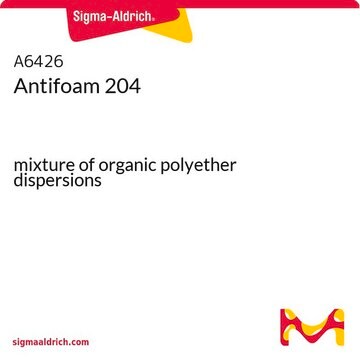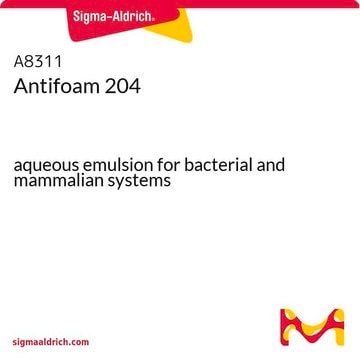All Photos(1)
About This Item
CAS Number:
MDL number:
UNSPSC Code:
12162002
PubChem Substance ID:
NACRES:
NA.23
Recommended Products
Quality Level
form
liquid
mol wt
Mn 1513
refractive index
n20/D 1.451
viscosity
~450 mPa.s(20 °C)
solubility
water: miscible (completely)
density
1.00 g/mL at 20 °C
SMILES string
O(C(CO)C)CC(O)C
InChI
1S/C6H14O3/c1-5(8)4-9-6(2)3-7/h5-8H,3-4H2,1-2H3
InChI key
DUFKCOQISQKSAV-UHFFFAOYSA-N
Looking for similar products? Visit Product Comparison Guide
General description
Polypropylene glycol is an addition polymer of propylene glycol and water. It is represented by the formula HO(C3H6O)nC3H6OH in which n represents the average number of oxypropylene groups. Polypropylene glycol is soluble in water and in certain organic solvents as aliphatic ketones and alcohols and insoluble in ether and in most aliphatic hydrocarbons.
Application
Polypropylene glycol (PPG)is widely used as an antifoaming agent. For example, it can be used to controlfoam in the production of Bacillus thuringiensis-based biopesticides fromsewage sludge.
It can be used in thepreparation of polyurethane(PU) elastomers. For example, it can be used tosynthesize PU elastomers with good acoustic absorption properties.
PPG-2000 can be used as a soft segment in the preparationof PU-based self-healing polymeric networks. These networks find application in the field of soft electronics.
It can be used in thepreparation of polyurethane(PU) elastomers. For example, it can be used tosynthesize PU elastomers with good acoustic absorption properties.
PPG-2000 can be used as a soft segment in the preparationof PU-based self-healing polymeric networks. These networks find application in the field of soft electronics.
Features and Benefits
- Long and flexible alkyl groups promotechain mobility, which facilitates rapid self-healing.
- The methyl groups present on the sides of thepolymer improve emulsification in water.
Storage Class Code
10 - Combustible liquids
WGK
WGK 1
Flash Point(F)
445.0 °F - closed cup
Flash Point(C)
229.44 °C - closed cup
Personal Protective Equipment
dust mask type N95 (US), Eyeshields, Gloves
Choose from one of the most recent versions:
Already Own This Product?
Find documentation for the products that you have recently purchased in the Document Library.
Customers Also Viewed
Izzuddin Zaman et al.
Nanoscale, 4(15), 4578-4586 (2012-06-19)
In spite of extensive studies conducted on carbon nanotubes and silicate layers for their polymer-based nanocomposites, the rise of graphene now provides a more promising candidate due to its exceptionally high mechanical performance and electrical and thermal conductivities. The present
Celeste R Brennecka et al.
World neurosurgery, 78(5), 469-480 (2011-11-29)
Current treatments for cerebral aneurysms are far from ideal. Platinum coils are prone to compaction, and currently used liquid embolics are delivered with angiotoxic agents. This work presents initial in vivo studies of a novel liquid-to-solid gelling polymer system (PPODA-QT)
John Texter et al.
Macromolecular rapid communications, 33(1), 69-74 (2011-12-03)
The controlled atom transfer radical polymerization of an ionic liquid, 1-(11-acryloylundecyl)-3-methyl imidazolium bromide (ILBr), from both ends of a telechelic poly(propylene oxide) (PPO) macroinitiator, end-functionalized with bromoisobutyryloyl is reported. The resulting highly water-soluble triblock, poly(ILBr-b-PO-b-ILBr) is multistimuli responsive. This new
L Hong et al.
Physical review. E, Statistical, nonlinear, and soft matter physics, 83(6 Pt 1), 061508-061508 (2011-07-30)
There are various arguments and models connecting the characteristic length associated with the boson peak vibrations ξ to the length scale of dynamical heterogeneity L(het). ξ is usually defined as the ratio of the transverse sound velocity to the boson
F Palazzi et al.
International endodontic journal, 45(2), 129-135 (2011-09-13)
To investigate the surface tension characteristics of 5.25% sodium hypochlorite and three recently introduced sodium hypochlorite solutions, which had been modified to reduce their surface tension: Chlor-Xtra, Hypoclean A and Hypoclean B. Freshly produced MilliQ water was used as a
Our team of scientists has experience in all areas of research including Life Science, Material Science, Chemical Synthesis, Chromatography, Analytical and many others.
Contact Technical Service





